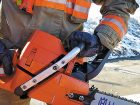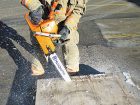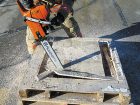
Tim-Bits: April 2015
Tim Llewellyn
Features Fire Ground TrainingChainsaws used in the fire service for ventilation are much more powerful than the average home-use chainsaw; the engines are bigger, the chains have large, wide teeth that are designed to chew through a range of materials, and the units are larger and heavier overall. Most firefighters rarely use chainsaws, and many are first introduced to these pieces of equipment during courses at entry-level fire academies.
Most instructors give many of the same coaching points during ventilation saw practice for both new and seasoned firefighters. Here are some common coaching points, along with a ventilation saw drill that will help firefighters build their confidence and skill.
- Wear full PPE, including eye, ear and hand protection when using saws.
- When starting a saw that is cold, allow it to warm up before revving the engine to full throttle. Upon starting, most chainsaws automatically run at a high idle. Hold onto the saw with both hands and allow the saw to run at high idle for 30 seconds to one minute – you will hear and feel the saw begin to run more evenly and smoothly.
- Do not apply the chain brake when warming up a saw – let the chain spin around the bar. This allows the lubricating oil to coat both the bar and chain, which makes the chainsaw perform better and last longer.
- When plunging the saw blade into something you want to cut, rev the saw to full throttle before you begin the cut. Keep the saw at full throttle during the cut and do not let go of or back off of the throttle until the cut is complete. I’ve learned that the majority of chain failures occur while the saw is being inserted into or retracted from the cut at less than full throttle.
- Do not cut in a line toward your foot.
- Once a cut is made and the saw is retracted from the material, immediately set the chain brake by rolling the hand and wrist on the roll-bar handle forward into the brake lever. When you switch hand or foot positions or move the saw to a new cut location, set the brake and stop the chain from spinning. The spinning chain is what causes injuries; if it’s not moving when we’re moving, the chance of getting hurt – or hurting someone else – decreases drastically.
- Once the saw is in place for the next cut, set the tip of the saw on the cut surface and squeeze the brake lever to release the brake. Put your hand back on the roll bar handle and begin the cut.
Training tip
Fire-service training with ventilation saws often starts with firefighters cutting holes on peaked-roof simulators to accomplish vertical ventilation. However, a peaked roof is no place for a firefighter to learn how to use a chainsaw. Basic saw training should occur on flat, firm, level ground where the simple saw manoeuvres can be practised to competence before introducing uneven surfaces and alternate hand and foot positions.
Capt. Jim Ellis from the Pittsburgh Bureau of Fire uses a training prop that is easily constructed and works great to introduce and reinforce saw handling. A wooden pallet is laid flat on the ground and is covered with a square piece of plywood sheathing (1.2 by 1.2 metres). The plywood is secured to the pallet in several places around the perimeter and also throughout the inner portion of the square. The firefighter then starts the saw and, using correct handling and foot-placement procedures, cuts a square shape just inside the outer edge of the plywood using his or her dominant hand. This square-shaped cut is repeated again two or three centimetres inside of the first cut until the firefighter feels comfortable enough to try a weak-hand technique. During these first few tries, the firefighter is allowed to move around and change foot positions for all sides of the cut until he or she feels comfortable. Next, the firefighter makes the square cut while standing in one location, changing hand positions to complete the cut correctly. Because the firefighter can’t move his or her feet, the exercise simulates standing on a roof ladder. The exercise serves to greatly increase the firefighter’s comfort level with the chain saw.
As with everything, training is key. Now get out there and cut some wood.
Tim Llewellyn is a firefighter for the Allegheny County Airport Authority in Pittsburgh, Penn., and an instructor for a number of fire academies and training faculties. llewellyn.fire@gmail.com
Print this page


